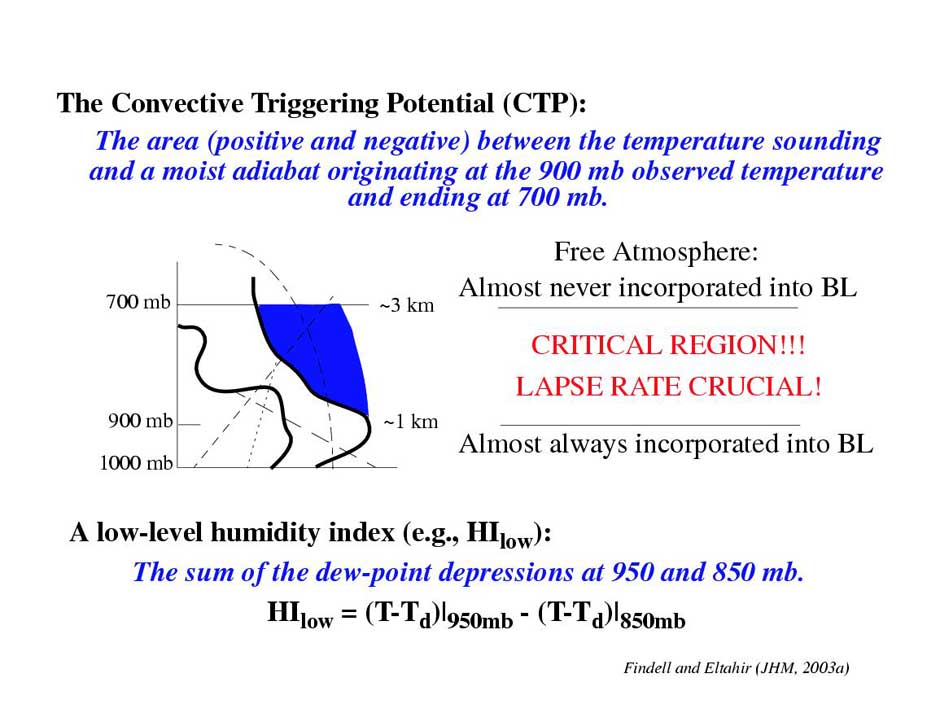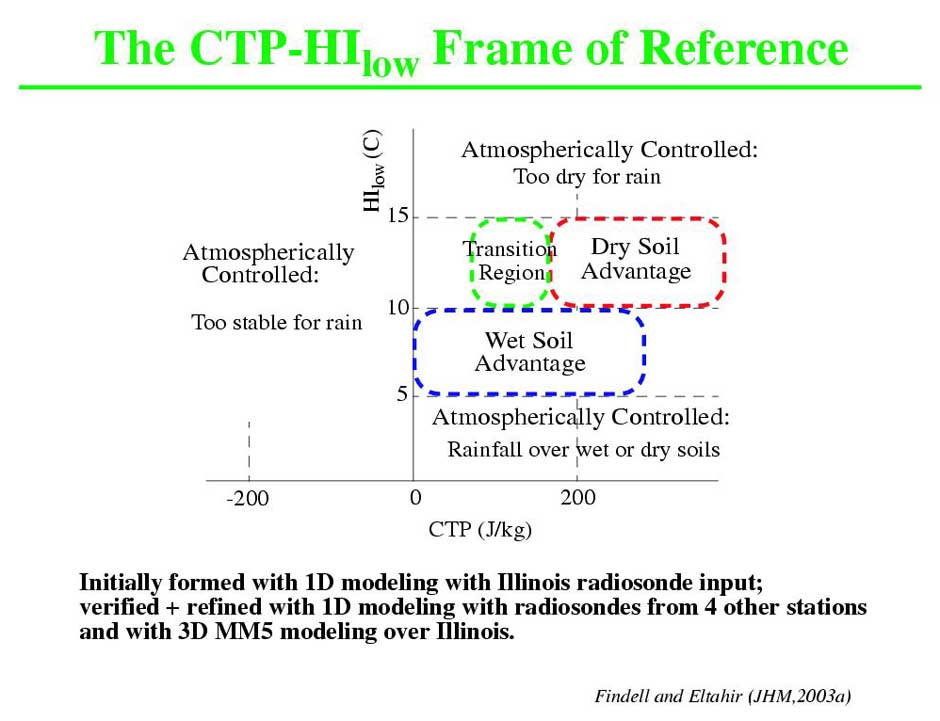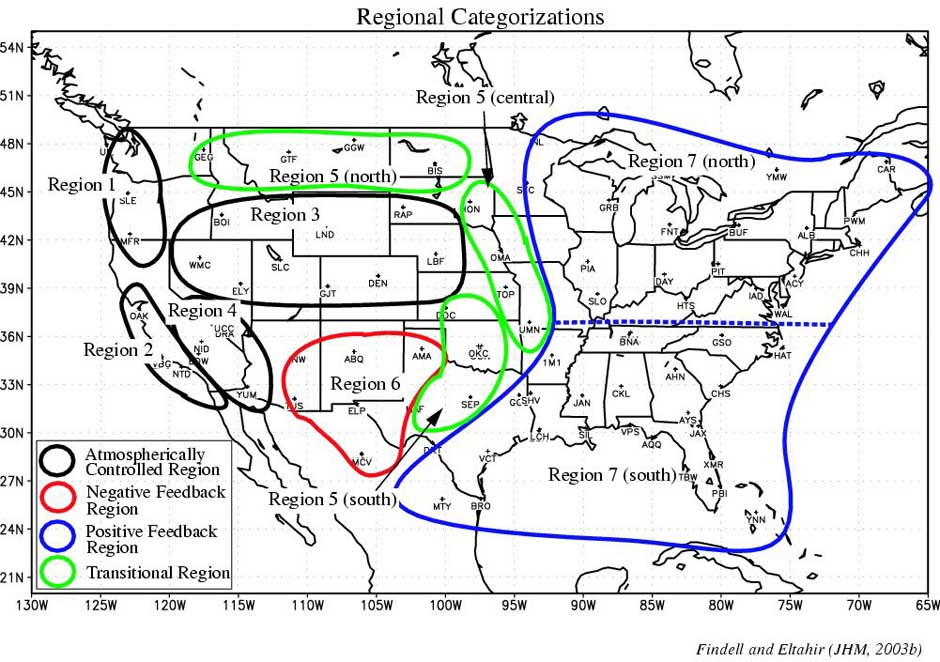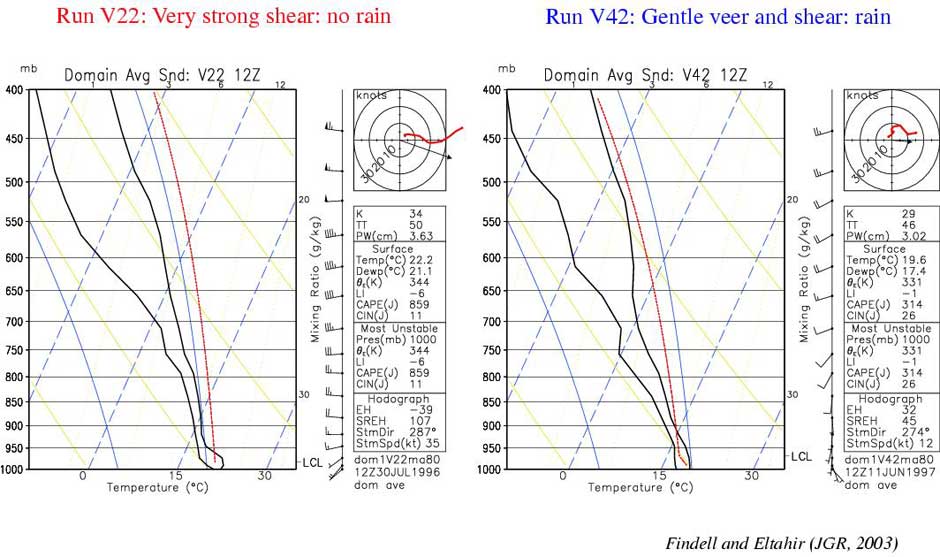Hi! Thanks for your interest in this work. You are welcome to download three papers discussing results of my PhD work, completed with Elfatih Eltahir at MIT.
Atmospheric Controls on Soil Moisture-Boundary Layer Interactions; Part I: Framework Development (JHM, 2003a)
In this first paper, we first describe a one-dimensional boundary layer (BL) model that was modified for initialization with observed early-morning soundings. We then define a new atmospheric thermodynamic measure, the Convective Triggering Potential (CTP) and provide case study examples to demonstrate how the CTP can distinguish early-morning atmospheric conditions favoring convection in regions of high sensible heat flux from early-morning atmospheric conditions favoring convection in regions of high latent heat flux.

The BL model described above is used with hundreds of early-morning soundings, primarily from Illinois but also from four other locations, to analyze the impact of soil saturation on BL development and the triggering of convection in different atmospheric settings. A framework for describing the important characteristics of early-morning soundings is developed to distinguish those soundings favoring convection over dry soils from those favoring convection over wet soils, and from those whose convective potential is unaffected by surface flux partitioning. This framework involves both the CTP and a low-level humidity index, HIlow.

Citation: Findell, Kirsten L., Eltahir, Elfatih A. B.. 2003: Atmospheric Controls on Soil Moisture-Boundary Layer Interactions. Part I: Framework Development. Journal of Hydrometeorology: Vol. 4, No. 3, pp. 552-569.
Atmospheric Controls on Soil Moisture-Boundary Layer Interactions; Part II: Feedbacks Within the Continental United States (JHM, 2003b)
In the next paper, soundings from stations across the contiguous United States are analyzed in the context of the CTP-HIlow framework to determine regions where a positive feedback between soil moisture and rainfall may be active, where a negative feedback may be active, and where the land surface condition does little to influence the development and depth of rainfall.

In atmospherically controlled regions, most of the days are either too humid, too dry, or too stable for fluxes from the land surface to influence the triggering of convection. In the too humid cases, rainfall will occur independent of land surface flux partitioning, while in the other cases, the early-morning atmosphere is either too dry or too stable for rainfall to be triggered, regardless of contributions of heat and humidity from the surface.
- In negative feedback regions, there are many more days when dry soils are more likely to trigger convection than days when wet soils are more likely to trigger convection.
- In positive feedback regions, there are many more days when wet soils are more likely to trigger convection than days when dry soils are more likely to trigger convection.
- In transitional regions, there are an approximately equal number of days with CTP-HIlow characteristics in the wet soil and dry soil advantage regimes.
Citation: Findell, Kirsten L., Eltahir, Elfatih A. B.. 2003: Atmospheric Controls on Soil Moisture-Boundary Layer Interactions. Part II: Feedbacks within the Continental United States. Journal of Hydrometeorology: Vol. 4, No. 3, pp. 570-583.
Atmospheric Controls on Soil Moisture-Boundary Layer Interactions: Three-dimensional Wind Effects(JGR, 2003)
In the third paper, a third and crucial dimension is added to the CTP-HIlow framework: the three-dimensional profile of the winds. Wind effects are analyzed in the context of simulations using MM5 over Illinois, and data from FIFE reveal the great importance of the low-level winds.

Initial conditions from two separate three-dimensional simulations with MM5. (Details provided in the paper.)
Early-morning soundings and hodographs (lowest 300 mb only) from two days that fall in the Rainfall Expected Regime of CTP-HIlow space. The run with strong, unidirectional shear produced no rain, while the run with gentle veer and shear produced rain. In subsequent runs with the initial and boundary condition winds reduced to 10% of the Eta model-produced input, rain occured in both cases.
Citation: Findell, Kirsten L., Eltahir, Elfatih A. B.. 2003: Atmospheric controls on soil moisture-boundary layer interactions: Three-dimensional wind effects. Journal of Geophysical Research: Vol. 108, No. D8.


